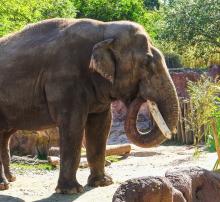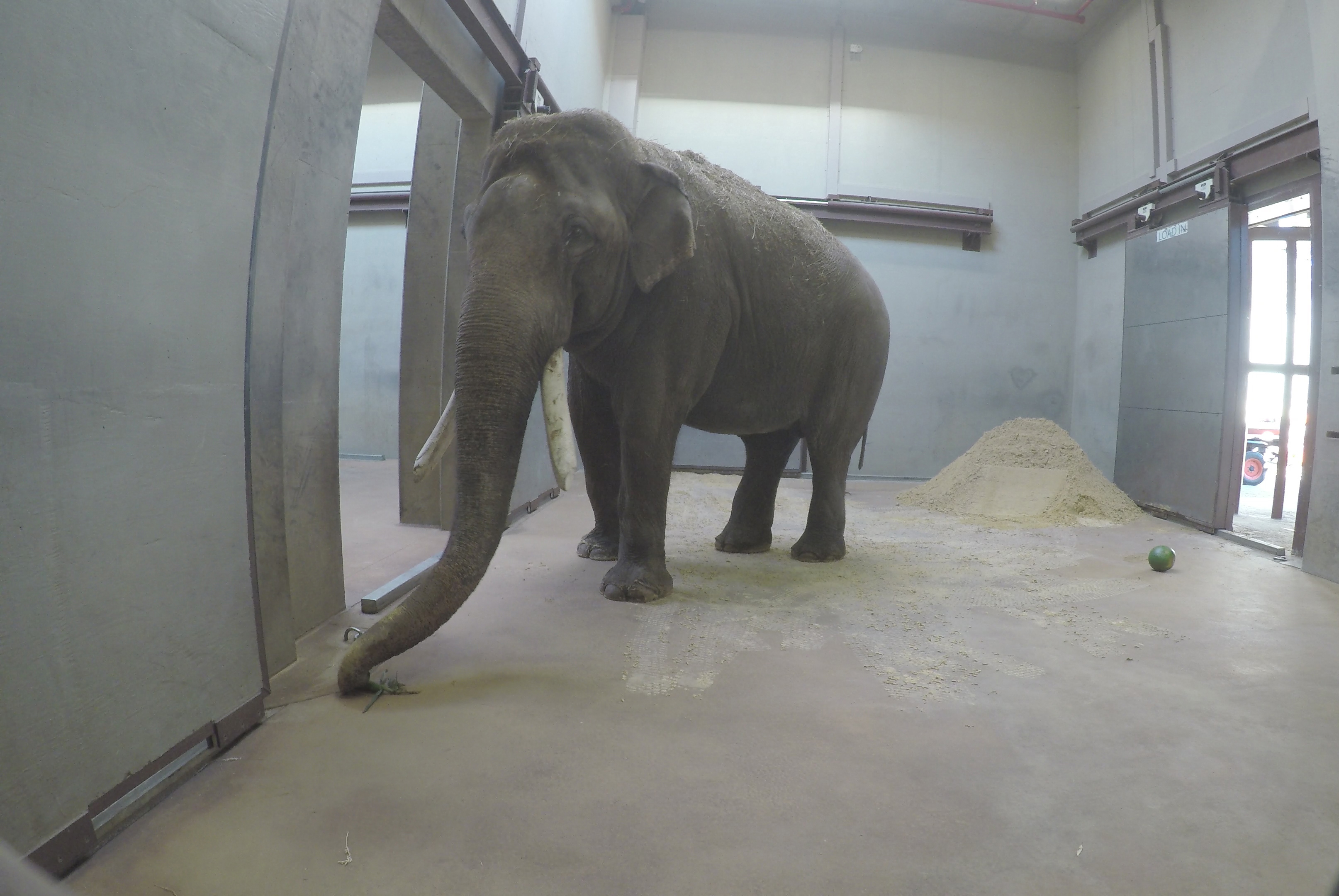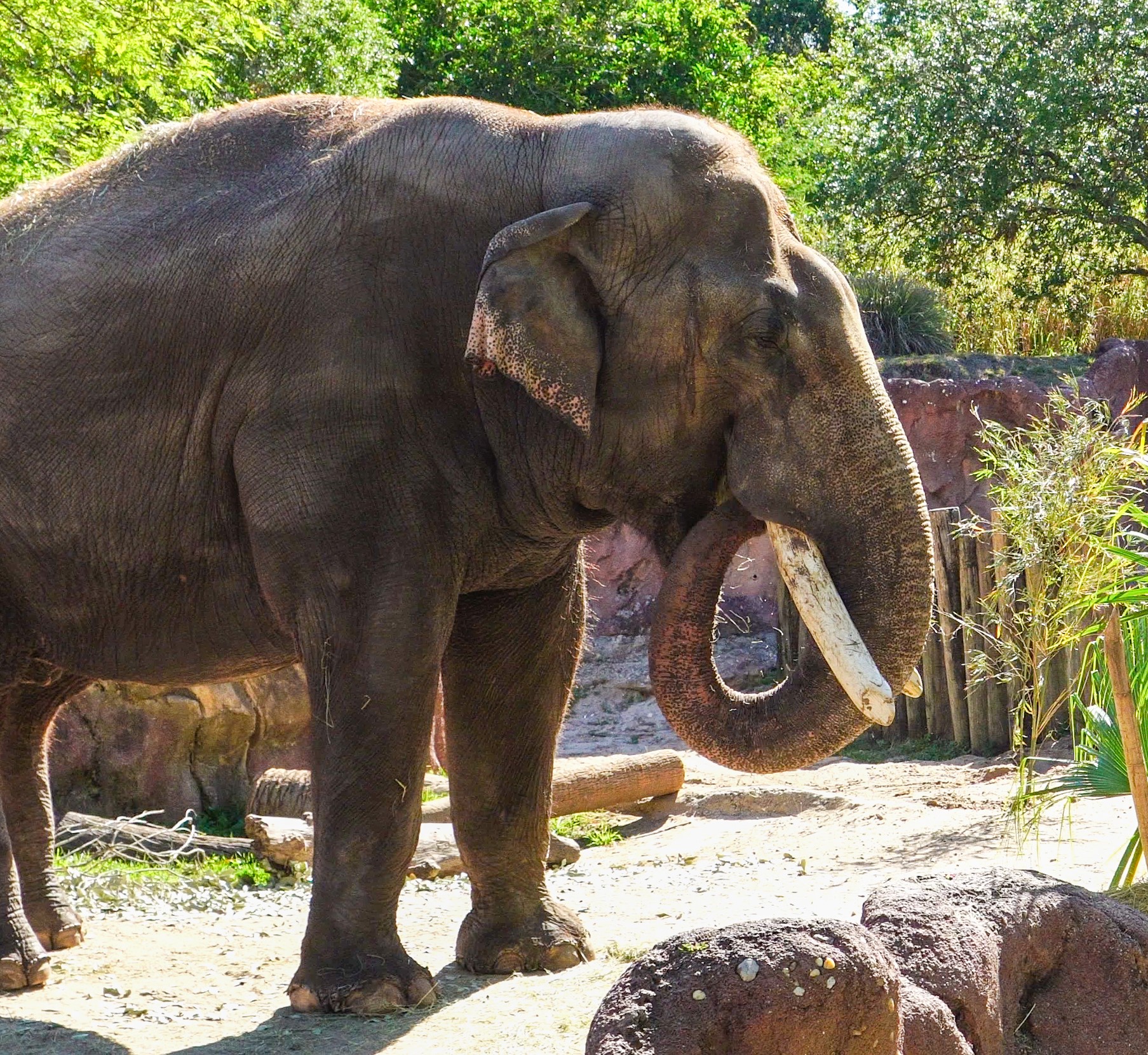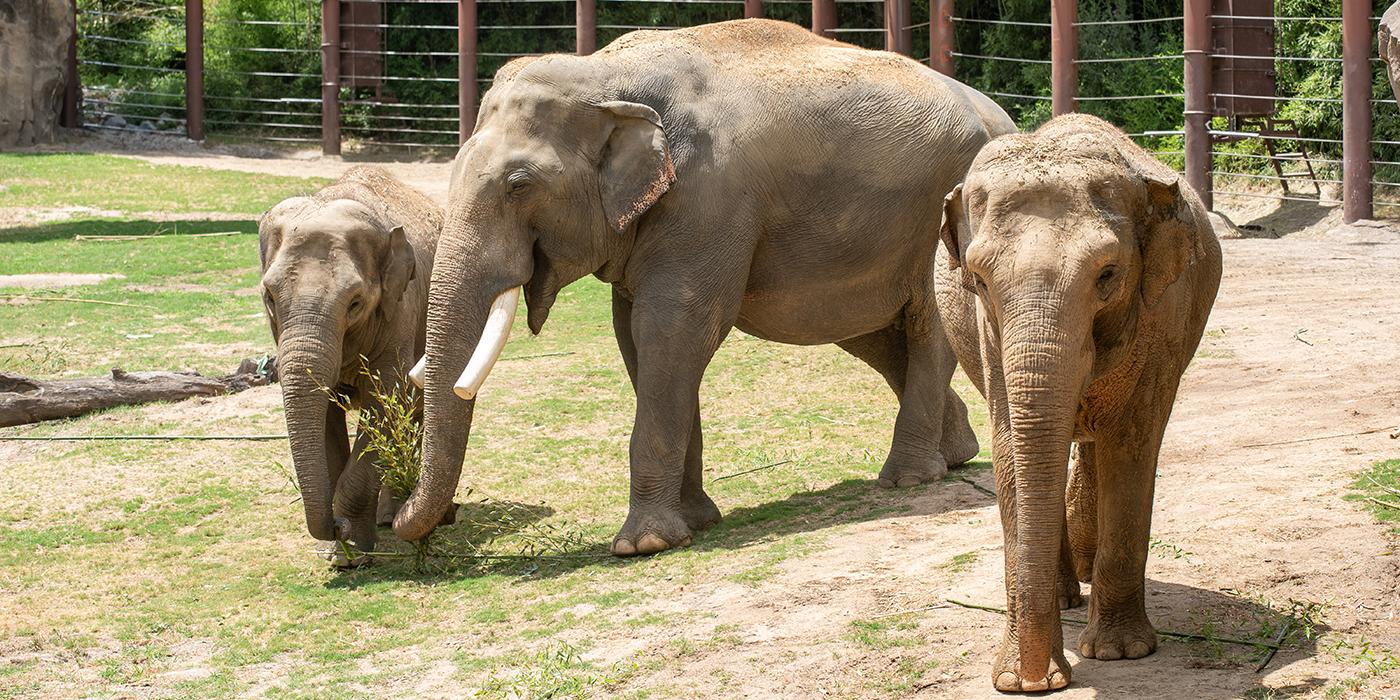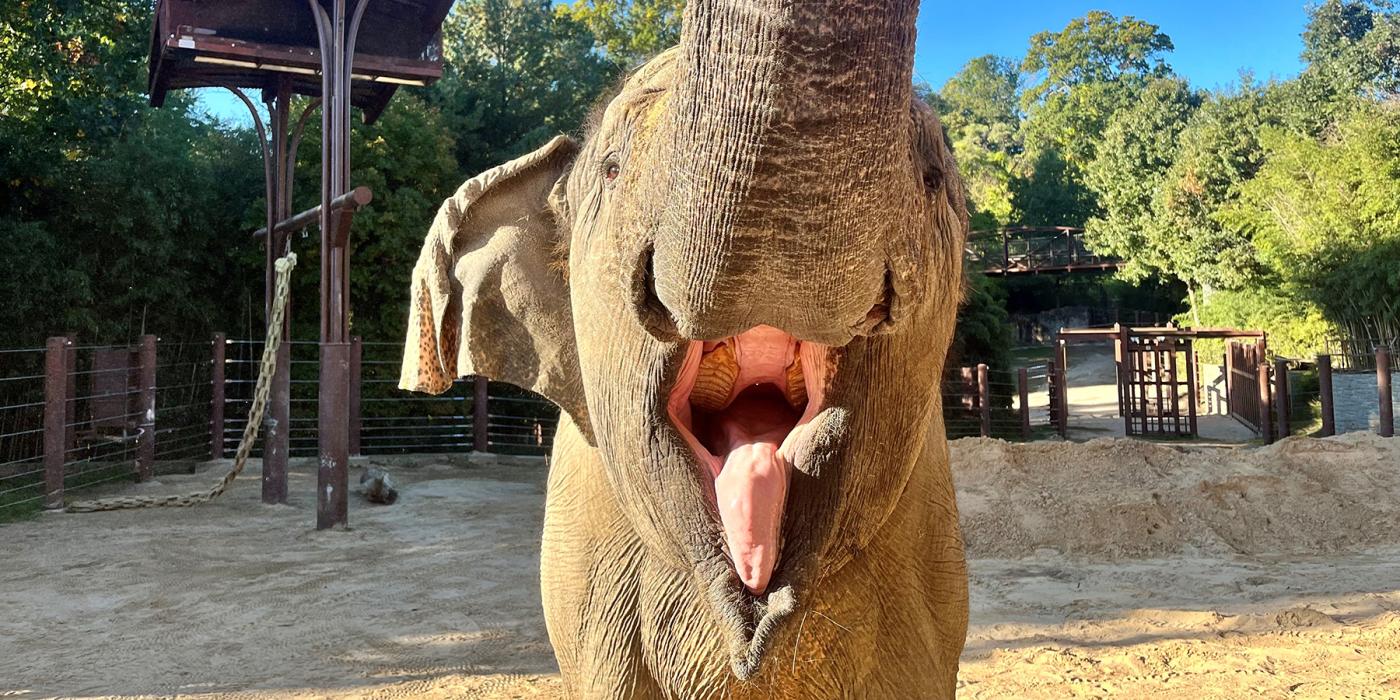Smithsonian’s National Zoo Welcomes Male Asian Elephant
Media: Scroll down for b-roll and high resolution photos
The Smithsonian’s National Zoo community is celebrating the arrival of a 36-year-old male Asian elephant named Spike. He joins females Ambika (70), Shanthi (43), Kamala (43), Swarna (43), Bozie (43) and Maharani (27) at the Elephant Trails exhibit, a habitat that includes space for socializing, training and playing while providing staff safe access to care for the animals. The Zoo received a recommendation to breed Spike and Maharani from the Association of Zoos and Aquariums’ Species Survival Plan (SSP). The SSP matches individual animals across the country for breeding in order to maintain a healthy, genetically diverse and self-sustaining population.
Spike came from Busch Gardens Tampa Bay in Tampa, Florida, and is on loan from Zoo Miami. An expert animal care team including keepers from both zoos monitored Spike during the 900-mile interstate trip, stopping every few hours to provide him with food and water to ensure he was doing well.
“Spike’s arrival ushers in an exciting new era for the Zoo’s elephant team,” said Tony Barthel, curator of Elephant Trails. “He will have a big presence here, and we look forward to seeing our herd interact with him. Spike lived with Kamala, Swarna and Maharani at the Calgary Zoo, so we anticipate that a reunion will elicit lots of excitement and energy among the quartet. We will be watching Spike and Maharani’s relationship closely, and we hope they show interest in one another once again. In the past, we have had success using natural breeding and artificial insemination to grow our herd. However, this is the first time our elephant team has the opportunity to study and manage natural breeding since we renovated this facility in 2013. Welcoming a baby elephant in the future will only enhance the social dynamic and welfare of our herd.”
In the months leading up to the move, keepers at Busch Gardens worked to acquaint Spike with his travel crate, which is approximately 12 feet tall, 20 feet long, 8 feet wide and 17,500 pounds. Elephant staff from the Smithsonian’s National Zoo also traveled to the Tampa park several times to meet Spike and his keepers and to learn about his care from the Busch Gardens team.
Per standard procedure, Spike will be quarantined in the elephant barn upon arriving at the Zoo. During this period, he will have access to two stalls inside the elephant barn and one off-exhibit outdoor yard. A team of keepers, nutritionists and veterinarians will care for him the entire time. Animal care staff will provide Spike with a variety of enrichment items, including browse, boomer balls and puzzle feeders to keep him active and encourage him to explore his new environment. Following quarantine, Zoo staff will begin the process of introducing Spike to the Zoo’s female elephants.
“Having an adult male elephant at the Smithsonian’s National Zoo will enhance the social experience of our herd and increase our ability to help this species through research and reproduction,” said Bryan Amaral, senior curator. “All of these efforts are vital to our mission to save Asian elephants, both here and in range countries where our scientists are working to understand and mitigate the threats these animals face.”
Spike was born July 2, 1981, at Zoo Miami. After Hurricane Andrew swept through Florida and damaged part of Zoo Miami’s elephant habitat in August 1992, Spike was relocated to the Calgary Zoo in Calgary, Alberta, Canada, where he shared a habitat with Kamala, Swarna and Maharani. Maharani bred with Spike and conceived while at the Calgary Zoo. Although she gave birth to two live young in November 2004 and August 2007, neither of the calves survived; in October 2012, she delivered a premature stillborn calf. Spike returned to Florida in September 2013 when he was transferred to Busch Gardens Tampa Bay.
Elephant Trails—where visitors can experience the sights, sounds and smells of a multi-generational Asian elephant herd—is the cornerstone of the Zoo’s campaign to save this endangered species from extinction. The Zoo’s rich history of caring for and studying Asian elephants spans more than a century. Scientists at the Zoo and Smithsonian Conservation Biology Institute (SCBI) are working to create a comprehensive view of Asian elephant biology, behavior, reproduction, genetics, migration, elephant endotheliotropic virus and the challenges surrounding human-elephant conflict. The Zoo and SCBI work with Asian leaders to implement land-use strategies that will reduce conflict between wild elephants and farmers and develop tools for managing and protecting elephants in areas threatened by agricultural conversion.
The Zoo will provide updates on Spike on Facebook, Twitter and Instagram. Online visitors can catch a glimpse of the Zoo’s elephants on the Elephant Cam.
More about Spike
Biography
- Spike was born July 2, 1981, at Zoo Miami. He is 36 years old.
- Spike weighs approximately 13,000 pounds.
- He is joining Ambika (70), Shanthi (43), Kamala (43), Swarna (43), Bozie (43) and Maharani (27) at the Elephant Trails exhibit.
- After Hurricane Andrew swept through Florida and damaged part of Zoo Miami’s elephant habitat in August 1992, Spike was relocated to the Calgary Zoo in Calgary, Alberta, Canada, where he shared a habitat with Kamala, Swarna and Maharani. All three females currently live at the Smithsonian’s National Zoo.
- Spike returned to Florida in September 2013 when he was transferred to Busch Gardens Tampa Bay.
- Spike arrived at the Smithsonian’s National Zoo March 23, 2018.
- He is on loan from Zoo Miami.
- The Zoo received a recommendation to breed Spike and Maharani from the Association of Zoos and Aquariums’ Species Survival Plan (SSP). The SSP matches individual animals across the country for breeding in order to maintain a healthy, genetically diverse and self-sustaining population.
- Spike is genetically valuable, as his genes are not represented in the North American Asian elephant population. He bred with Maharani while at the Calgary Zoo. She conceived three times. Although she gave birth to two live young in November 2004 and August 2007, neither of the calves survived; in October 2012 she delivered a premature stillborn calf.
Travel
- The travel crate is approximately 12 feet tall, 20 feet long, 8 feet wide and 17,500 pounds.
- The interstate trip is 900 miles. The team left Tampa, Florida, at 12:30 p.m. March 22 and arrived in Washington, D.C., at 8:13 a.m. March 23.
- An expert animal care team including keepers from both zoos monitored Spike. They include:
- Tony Barthel, curator of Elephant Trails, Smithsonian’s National Zoo
- Rebecca Riley, animal keeper, Smithsonian’s National Zoo
- Kayleigh Sullivan, animal keeper, Smithsonian’s National Zoo
- Jeff Andrews, vice president of zoological operations, Busch Gardens Tampa Bay
- Jan Duncan, manager of animal husbandry, Busch Gardens Tampa Bay
- Dana Boyles, senior animal care specialist, Busch Gardens Tampa Bay
- Dominique Keller, senior veterinarian, Busch Gardens Tampa Bay
- The team stopped every few hours to provide him with food and water and to ensure he was doing well. The list of supplies includes:
- 12 bales of hay
- 6-10 banana trees
- 10 watermelons
- 1 case of honeydew melons
- 1 bushel of apples
- 1 bushel of corn
- 30 gallons of water, which can be refilled as needed
- 6 bags of elephant grain and biscuits
Acclimation
- Dana Boyles will remain at the Smithsonian’s National Zoo through March 30. She will work alongside the Zoo’s elephant team to help Spike acclimate to his new home and assist with management and husbandry transition.
Photo credits: Roshan Patel, Smithsonian's National Zoo (photo one) / Busch Gardens Tampa Bay (photo two)
Related Species:
Image Gallery

